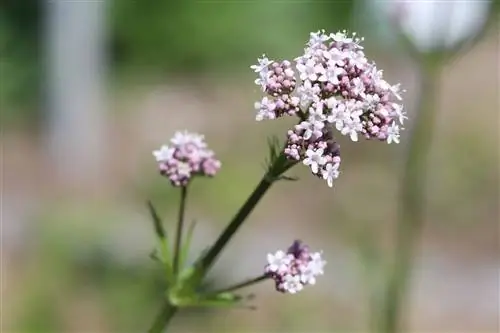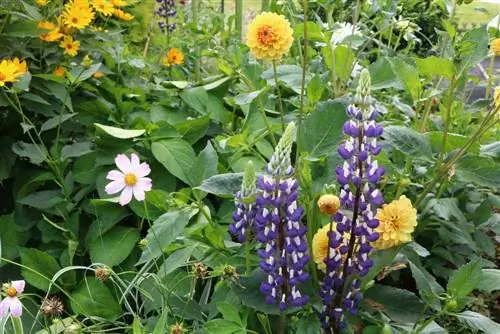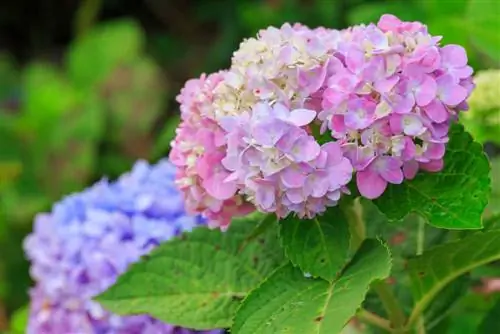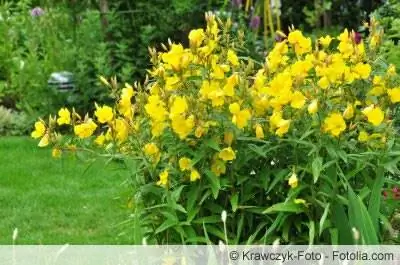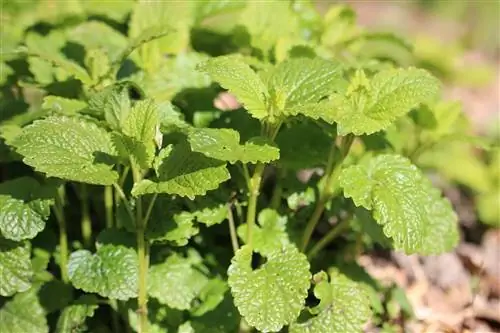- Author admin [email protected].
- Public 2023-12-17 03:39.
- Last modified 2025-01-24 12:45.
Valerian is known almost exclusively for its calming effects, but it also has convincing visual appeal. In the right location, it quickly produces lush flowers and is a wonderful addition to the bed or pot long before the harvest. But only if the care is right.
Valerian is unfortunately a rarity in the herb garden, even though it is very easy to care for and is even ideal for hobby gardeners without experience and a green thumb. And even those who don't want to use the medicinal effects of the calming herb will enjoy the richly flowering plants. Valerian is definitely a wonderful addition to the garden or pot. Even if the grateful plant has few demands, the care still has to be right.
Location
Valerian or Valeriana officinalis, as it is called by its botanical name, thrives best in warm, dry and sunny locations. This means it fits well in the rock garden, on a wall or on the south-facing balcony. Occasional cold winds don't bother it, nor does accumulating heat - so the planting site can be sheltered or airy; valerian is not picky in this regard. Apart from these factors, ensure there is enough space at the location. The flowering branches of the shrub can reach a height of up to two meters and the valerian likes to spread out over time.
Substrate
Valerian does not require many nutrients or moisture, so the substrate chosen should be loose, permeable and dry. Normal garden or pot soil mixed with sand or gravel and some coconut fiber meets these requirements optimally. But it can also be the existing stony ground on which hardly anything else thrives. Even cracks in walls are enough for Valeriana officinalis.
Plants
Valerian can be planted either in spring after the last frost or in autumn before the first cold snap. In preparation, the soil should be loosened well so that the roots can spread quickly and gain a foothold. The area should also be free of weeds. If it is in the desired location, the valerian is lightly watered. This measure should be repeated within the first few weeks unless it rains.
Tip:
Valerian seeds can be found commercially, but planting pre-grown plants is quicker, more successful and easier. These also show more quickly whether the location is suitable.
Pouring
Apart from the initial period after planting, valerian likes it dry. Watering is therefore rarely necessary in the garden because the plants take care of themselves. Additional watering is only necessary in cases of prolonged drought, high temperatures and when cultivating in containers. Fresh tap water can be used for this; Valeriana officinalis is not bothered by the lime content. The substrate should be allowed to dry well between waterings.
Fertilize
Valerian is undemanding and generally does not benefit from additional fertilization. In fact, he quickly becomes oversupplied and suffers as a result. The exception here is with plants that show slower growth after several years in the same location or in a pot. Depending on the culture, these can optionally be repotted and provided with fresh substrate and cared for sparingly with a mineral fertilizer. If you want to harvest the valerian anyway and change the location every now and then, you don't have to worry about this.
Blend
When it comes to blending valerian, less is more. If the plant becomes very dense, it can be easily thinned out in spring. As a result, the flowers are usually more lush. Broken branches, dried plant parts and wilted flowers may be removed at any time.
Wintering
Valeriana officinalis is robust and resilient, this also applies to winter. If it was planted in the garden, it does not require any additional protection. And no preparatory care either. However, in a pot or bucket. The planter can either be covered in several layers of garden fleece or brought indoors. In any case, ensure there is no frost and sufficient light. If the valerian is indoors, it should be watered sparingly every few weeks.
Propagation
If you want to propagate valerian, you have two options to choose from. Namely lowering and ground shoots. The Valeriana officinalis forms ground shoots on its own; all that is required is patience. If they are about ten centimeters high, they can be cut off with a sharp spade and dug up. You can then go directly to the desired location.
If you want the propagation to take place more quickly and in a targeted manner, we recommend using lowering pins:
- To do this, strong, long side shoots are bent onto the ground - without bending them.
- 10 to 15 cm from the tip, a short section of the branch about two fingers wide is pressed into the ground and weighed down with a stone.
- The protruding shoot tip is attached to a rod and directed straight upwards.
- After about a month, you should check for the first time whether the buried section has already developed roots.
- If this is the case, the lowering plant can be separated from the mother plant and planted in the desired location.
Harvest
The flowers and roots of valerian can be used for teas, extracts and infusions. The flowers can be harvested annually during the entire flowering period from May to August. The roots are only suitable for use from the second year onwards. They are harvested between September and October. To do this, they are dug up, freed from soil and fibers and air-dried.
Typical diseases and pests
Valerian is less susceptible to parasites and pathogens. Only aphids and powdery mildew occur occasionally. If aphids appear, their natural predators should be used. Ladybugs, which can be purchased in stores and even ordered online, have proven to be particularly effective. To encourage them to destroy the lice quickly, it helps to stretch a tight-meshed net over the infected valerian and release them underneath.
Mildew usually attacks valerian in late summer and manifests itself as white-grey deposits on the leaves. A mixture of one part fresh milk and eight to nine parts water helps against this fungal disease. The solution is sprayed onto the plant and left there for about an hour. It should then be rinsed thoroughly. Films or trays underneath prevent it from penetrating the soil. If necessary, the treatment can be repeated several times a week until the fungus disappears. Since powdery mildew occurs more often in very dry, hot weather, it is often easy to prevent. All you have to do is spray the valerian with water every now and then so that the humidity increases slightly.
Frequently asked questions
Is valerian poisonous to animals?
Valerian is also known as cat's weed because they are strongly attracted to the smell of the plant and can even get intoxicated by it. In small doses this is harmless. But as is so often the case, it's the quantity that makes the poison. If four-legged friends are constantly exposed to the fumes or even eat them, this can lead to fatal liver failure.
Can taking valerian be addictive?
Valerian is not considered addictive, but long-term use can cause withdrawal symptoms.
What you should know about valerian in brief
- The valerian (Valeriana officinalis) is also called eyeroot, witch's herb, tripod, lady's root and tollerjan.
- In total, this plant species includes around 150 different species, ranging from perennials to subshrub species.
- It grows mainly in Europe, but is also widespread in a few areas of North and South America.
- The native valerian grows on the edges of paths and forests and is approx. 50 cm to 1 meter high.
The name is derived from the Latin valere and means strong, he althy. The German name is said to come from Baldur, the son of Odin and Frigga. Valerian has had a good reputation as a medicinal plant for ages. The most medicinal part of the plant is the root. However, it smells very unpleasant, very rancid, when dug up.
Cultivation and harvesting
Valerian looks wonderful in the perennial garden. Its tall, slender stems, which have white to pink flowers and pinnate leaves, also smell very good. The flower stalks begin to grow from April and sometimes reach a height of up to 2 meters. The plant blooms in July/August, and the tall, gently swaying creatures in the summer wind look cute as they perch so boldly above the other plants. The scent of the flowers almost magically attracts cats, which is why valerian is also called cat's herb. Valerian is a perennial plant and develops many sprawling runners. Valerian still grows very slowly. It is best to sow it in a seed box in spring and grow it under glass. Then, when the night frosts are over, plant it at a distance of 60 cm. The plant loves sunny and slightly moist conditions. The rootstocks of the second year are harvested. First the root fibers must be removed before the roots can be dried.
Use, medicine
Valerian calms the nerves and helps you sleep soundly. A decoction of the root is effective against nervous headaches and to strengthen nerves. If you drink valerian tea about an hour before going to bed, for several days in a row, it promotes your natural sleep rhythm. Valerian is a healing herb, but should not be taken over a long period of time. Too high doses can cause side effects, lethargy and headaches. In ointment form, made from roots and leaves, valerian heals wounds and skin diseases. However, valerian can definitely replace psychotropic drugs because it helps with many psychosomatic illnesses. Since valerian does not make you tired, it can also be used for exam anxiety; it has an anxiety-reducing effect. Valerian is not addictive, but at higher doses over a longer period of time, withdrawal symptoms such as restlessness, insomnia and delirium can occur.
Valerian tea for sleep disorders
Add two tablespoons of the dried and grated root to 1 cup of water and simmer in an enamel pot with a lid for 20 minutes. Allow to cool, strain, heat again, sweeten with honey if necessary and drink.

